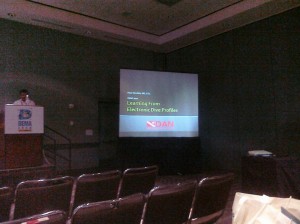Wow! Lots of cool stuff today…maybe even a bit too much. Here’s the quick preview:
This was the plan:
9-11am DAN Instructor/Trainer update
11am-Noon PADI Public Safety Diver Program
Noon-1245 Walk the show floor
1245-1345 DAN Controversies of in-water recompression
1400-1500 DAN Diving Emergencies
1500-1630 PADI Risk management
1630-1730 DAN Electronically recorded dive profiles
What happened:
The DAN Instructor/Trainer update was excellent! The course revisions look great. Good direction with course updates and course consolidation, making the materials more diver-friendly and updates based on feedback from DAN Examiners, Trainers and Instructors. The short version: The DAN Oxygen and Advanced Oxygen courses are merging. The AED for Scuba course is going away, being replaced by their full Basic Life Support/First Aid (BLSFA) program that includes the AED skills in a logical sequence of primary care. The DEMP (Diving Emergency Management Provider) program now includes the revised O2 course, BLSFA, Hazardous Marine Life Injuries and Neurological Exam for Scuba. Hazardous Marine Life is also being revised to include freshwater aquatic life hazards.
PADI Public Safety Diver–WOW!!! PADI is partnering with the pros at Underwater Criminal Investigations to expand this program from the first program (a basic intro) to expanding it into comprehensive training including evidence recovery, body recovery (yes, bodies), vehicle recovery and much more. From an instructional point of view, this looks to be an awesome evolution.
DAN programs: In-water recompression was an eye-opener. I knew of some of the hazards based on my Diver Medic training and the obvious needs for better support during recompression therapy. Good case studies and questions. The Dive Emergency planning seminar was awesome. I’m happy to say I’ve included some of their ideas when I teach my Rescue Diver courses, but I learned a lot. For example, an Emergency Assistance Plan isn’t just “where is the nearest chamber?” From a accident history problem, we’re more likely to run into a medical or trauma problem that is due to heart problems than a truly diving-related problem. Think about it. If someone has a heart attack while playing golf, it’s not a “golfing accident.” If they have a heart attack while diving, though, it’s almost always a “diving accident.” We need to plan for more than just diving problems. As with all other emergency scenarios, training is crucial. We need to practice what to do during an emergency. For those of you that went through Rescue Diver a while ago, think about taking a refresher!
Ok…at that point, I figured I need to walk the show and see some of my friends, so I skipped PADI’s Risk Management seminar. [I figured I just had a small dose of risk management in the DAN seminars.] Walked the show for a while, talked to folks at DAN, PADI, Project AWARE, saw my friends from points south–TJ in the Caymans, Patty from Roatan, etc.
Back to the training…What can we learn from electronically recorded dive profiles? A lot–and probably the most important, that we don’t know enough yet! Combine this presentation and the others earlier in the day and the nutshell version is “Dive conservatively!” Another way to say it, “don’t dive stupid.” There are lots of profiles that seem to be very low risk. There are also a lot of profiles that seem high-risk. Diving really deep, staying long, missing decompression and safety stops, running out of air and making fast or “explosive” ascents, etc. can lead to a really, really poor outcome.
